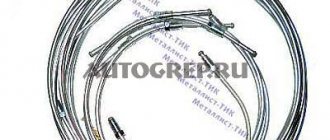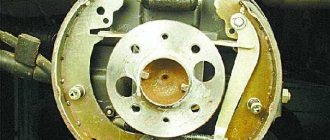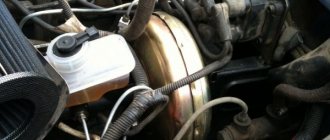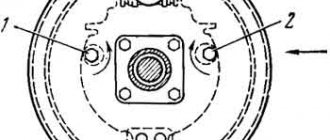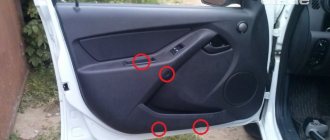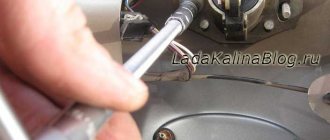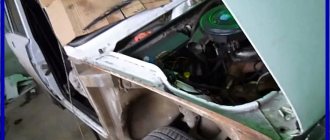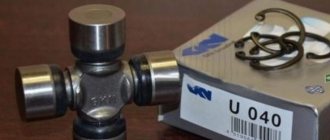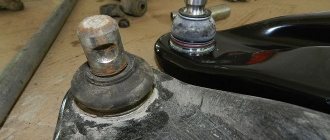The brake system of a car requires timely monitoring to identify possible faults and must be checked every six months.
| Standard brake pipe repair kit for VAZ 2110. |
It is best to time it to coincide with the end of the winter period, as it is the most difficult to operate. In winter, the road surface is treated with chemicals that have an aggressive effect on all elements of the body, including the brake system.
When checking the brake system, you need to check the condition of the brake fluid pipelines, brake hoses, their fastening, as well as the condition of the brake pads. At the same time, cracks, abrasions of the outer coating, swelling, leakage of brake fluid and other damage are not allowed on the brake pipes.
It is advisable to carry out the test using a powerful lamp and a mirror so that any malfunction can be identified. Timely replacement of worn-out brake system components will guarantee your safety.
If damage to the brake hoses or pipelines is revealed during the inspection, then a mandatory replacement of the VAZ 2110 brake pipes and hoses will be required.
Most often, you have to change brake hoses after a certain mileage, namely in the region of 70-100 thousand kilometers, or when a malfunction is detected. Brake pipes last quite a long time and replacement of VAZ 2110 brake pipes occurs when they are corroded or mechanically damaged.
To replace, you need to purchase a set of VAZ 2110 brake pipes. In this case, you can purchase either brake pipes already bent to the desired configuration, or simply straight ones, which will need to be given the profile of the removed brake pipes.
| Video of replacing brake pipes on front-wheel drive VAZ cars. After watching this video, we can say that replacing brake pipes on a VAZ 2110 at home is not particularly difficult. |
It is better to purchase ready-made (factory bent) tubes, which will significantly simplify the process of replacing them.
If you purchase straight brake pipes, you will need a tool to bend them (you can use a spring with a suitable internal diameter where the pipe should fit when bent). Steel double-layer brake pipes are more reliable.
It will be more economical to purchase an unmolded copper line, but you will need to bend it yourself, observing all the necessary dimensions, which will require more time to replace.
To work, you will need an inspection hole or overpass. Carrying out the replacement simply on a level surface with the help of a jack is also possible, but it is quite labor-intensive and dangerous in terms of work safety.
To replace faulty brake hoses or tubes, you will need a special wrench for working with the VAZ 2110 brake system, as an addition and a gas wrench (first number) for disconnecting the fittings on the master brake cylinder, working cylinders, as well as in the brake hose connections.
It is also necessary to have a set of wrenches for: 10, 13/14, 17 mm, composition VD 40 or similar and new brake fluid.
The procedure for replacing brake pipes on a VAZ 2110
- Before starting the replacement, you need to disconnect the terminal from the battery for safe work;
- Replacement of brake pipes must be done starting from the main brake cylinder in turn to each wheel cylinder;
- The wheel bolts are loosened and the car is jacked up to a convenient height for work;
- The brake pipe fittings are removed one by one from the brake master cylinder and the holes are closed with plugs;
- The pipeline is carefully released from plastic and metal fasteners towards a specific wheel. The protective plastic box must be removed;
- The brake hose fitting on the wheel is unscrewed, where the tube is replaced and the damaged line is removed;
- The new brake pipe is installed in the opposite direction, “going” from the wheel to the brake master cylinder;
- All tube holders are put back into place; those damaged during dismantling are replaced with new ones;
- The new pipeline is blown through with compressed air and connected.
When is it necessary to replace pipes and other elements of the brake system?
Brake pipes are changed quite rarely. The need for this arises only if the machine has been in use for a long time, in unfavorable conditions conducive to the development of corrosion, or in the event of any mechanical damage.
You can assess the condition of these components yourself by looking under the car body, or by bringing your “iron horse” for inspection by technicians from the service center. According to the regulations, diagnostics of all components of the brake system must be carried out at least once a year, preferably at the end of the winter period. You can combine the inspection with the next oil change.
Rubber hoses on all wheel cylinders must be replaced, regardless of their condition, every 70-100 thousand km. mileage Pipelines are replaced only as needed.
To carry out the work you will need the following tools:
- Jack;
- Phillips screwdrivers;
- Set of wrenches for: “10”, “14”, “17”;
- Clamping key to “10”;
- Clamping pliers;
- Balloon wrench;
- Anti-corrosion composition;
- Brake fluid (to replenish the system).
What to consider?
The design of the brake system and the principle of its operation are almost identical for all car models. Accordingly, the method of its restoration is also the same for all brands of vehicles.
All pipeline repair work can be carried out in a repair pit, overpass or on a flat area by lifting the machine with a jack.
A set of tubes can be purchased at any auto store. You can order a pipeline of a given length, already bent as required, specifically for a specific car model. Or you can buy a universal copper line, and then give it the required shape and length yourself. The latter option is more economical, however, and there is much more fuss.
The main stages of replacing brake pipes on a VAZ 2109, 2110
You can replace the pipeline lines in the direction from the main brake cylinder to each wheel according to the following diagram.
- Disconnect the battery terminals.
- Raise the car to the desired height using a jack.
- Remove the car wheels.
- Using a “10” wrench, unscrew the nut securing the tube to the master cylinder and install a plug for dust and dirt in the supply hole.
- Carefully release the pipeline towards the wheels. Remove the protective plastic box and remove the line from the metal and plastic holders. Try to do this carefully so as not to damage the clips.
- Unscrew the brake hose fitting and remove the damaged line.
- Start installing the new tube in the opposite direction: from the wheel to the master cylinder.
- Reinstall all holders, replacing worn or damaged parts as necessary.
- Blow out the pipeline with compressed air, connect it to the system and bleed the brake system according to the instructions, replenishing the missing fluid as necessary.
Replacing brake pipes on a VAZ 2110
The most important system of any car is the brake system. It is this that guarantees full control of the car on the road and, as a result, safety for passengers and the driver. VAZ 2110 is no exception.
The VAZ 2110 brake system consists of the same parts as most modern cars with a hydraulic brake system:
- Brake pedal (this is what the driver acts on when braking is necessary).
- Brake booster (increases braking force and transfers it to the master cylinder).
- Master brake cylinder (forms brake fluid pressure in the system and transmits it to the wheel brake cylinders).
- Wheel brake cylinders (directly cause the brake mechanism to operate - they press the brake pads with the required force against the brake drum).
- Connecting brake hoses (transfer brake fluid from pipelines to the wheel brake cylinders).
- Brake lines (transfer brake fluid from the master cylinder to the wheel brake cylinders - here brake hoses are also present in the transmission system).
As is clear from the diagram above, the most important role in transmitting braking force (via brake fluid) belongs to the brake pipes and connecting brake hoses.
They are the ones that most often need to be replaced. Although they are made from completely different materials.
Materials
Content
Brake hoses for the VAZ 2110 are made of special multilayer reinforced rubber that retains its elasticity at critical operating temperatures. There are special fittings at both ends of any brake hose. Their function is to connect on one side to the brake pipe, and on the other to the wheel brake cylinder.
Brake pipes for the VAZ 2110 are always made of metal. In each specific case this could be:
- Copper (most car enthusiasts consider it the most preferred material for brake pipes - as it can withstand greater pressures compared to steel of the same thickness. The reason for this is ductility).
- Aluminum alloy (its qualities are somewhere between copper and steel, but it is often confused with steel that is simply galvanized or coated with some other composition to protect against corrosion).
- Steel (cheaper than copper. But it is more brittle and tends to corrode quickly).
Common reasons for replacement
The most common reasons for replacing brake pipes:
- Clogging (due to dirt getting into the brake fluid).
- Mechanical damage (most brake lines are protected by special parts, but this is not a panacea - sometimes the pipes are simply cut off).
- Corrosion (in this case, protective coatings do not help either - the tube stops holding pressure and starts to leak).
Algorithm for replacing brake pipes on a VAZ 2110
The process of replacing brake pipes on a VAZ 2110 consists of sequentially dismantling 8 old ones and placing new pipes in their place.
Let's look at this step by step:
- Using a large rubber medical bulb or a large medical syringe, pump out the brake fluid from the brake reservoir.
- Using the necessary tools, dismantle the protective elements and fastenings of the brake line to the bottom of the car.
- Unscrew the fittings using the keys of the required number. If necessary, fix the second fitting with another key in the opposite direction.
- Remove old brake pipes. New ones are placed in their place.
- New brake pipes are fixed to the bottom of the car using fasteners. Install protective plates.
- Pour new brake fluid into the brake reservoir. “Pumping” the system.
As you can see from the description, the whole process is quite simple. But there are also several important nuances.
Important!
- When installing, balance your efforts with the material of the brake pipe - steel, unlike copper or aluminum, can withstand only slight bends 1-2 times. After that they just burst. Bends are often used to adjust the length of a brake tube.
- Remember that drained brake fluid should never be reused. Only a new one needs to be added to the system!
- When replacing the rear brake pipes leading to the rear wheels of a VAZ 2110, do not forget to return the so-called “sorcerer” to its place in the system (the correct technical name is “hydraulic system braking torque regulator”). In its absence, braking leads to loss of vehicle controllability).
- Sometimes, when we are not talking about completely replacing the brake pipes, but only need to clear the blockage in one of them, partial dismantling is used without draining the brake fluid. To do this, where the brake pipe is disconnected, the system is sealed using suitable caps (for the line and cylinder) and bolts (for the brake hoses).
And in conclusion, we need to remind you once again about the need for the so-called “bleeding” of the brake system of the VAZ 2110 - here you will need an assistant.
Features of replacing brake hoses
When replacing brake pipes on a VAZ 2110, it is a good idea to check the condition of the elastic hoses. If you notice even minor cracks and mechanical damage on them, replace them. Also install new hoses if the service life of the old ones has already exceeded the required limit.
The elastic hose replacement scheme consists of the following steps:
- Clean the cylinder well with a wire brush, treating it with rust remover if necessary;
- Using a “14” wrench, unscrew the wheel caliper fitting;
- Plug the caliper hole to prevent dirt from getting into it;
- Using wrenches “17” and “10”, unscrew the fitting and disconnect the hose from the tube;
- Remove the elastic hose holder;
- Install the new hose in sequence from tube to caliper.
Replacing the brake system elements described above is not a very pleasant matter. However, if you are going to replace the piping and hoses, be glad that you won't have to do it anytime soon.
The brake system appeared on the first cars. Its presence has become the key to the safety of the driver and passengers. The first brake system did not have a complex mechanism of action and consisted of several mechanical parts that created the necessary friction on the wheel drive for its subsequent stopping.
The second stage in the development of the braking system was the application of the laws of hydraulics. With this method of braking, the interaction between the brake pedal and the working parts of the brake system is carried out using a special fluid called “brake fluid” (or abbreviated as TF). Brake fluid allows you to stop your vehicle more efficiently. In addition, the use of brake fluid softened the pressure on the brake pedal and made driving more comfortable.
For successful circulation of brake fluid from the brake drive system to the working parts, it is carried out through special pipes. Initially, they were made in the form of hoses, but since they were unreliable, they were replaced by another material.
Replacing a brake hose on a VAZ 2110
Brake hoses made of high-quality material usually have a long service life. Which VAZ 2110 brake hoses are better? Those that are made of high-quality rubber and preferably from a reputable manufacturer.
The reasons why this part fails are as follows:
- The car is not new.
- Its mileage is several tens of thousands of kilometers.
- The car was idle for a long time.
What is needed to replace hoses
Content
In order to change brake hoses on a VAZ 2110, you must have:
- wrench for brake pipe fittings;
- screwdriver;
- wrench.
Where is the part located?
If the car is front-wheel drive, then there will be 2 VAZ 2110 brake hoses located in front and behind it. To get to the front brake hoses, just remove the wheels. In order to find the rear brake hoses, you need to use the inspection hole and unscrew the fastening nuts.
Location of the brake hose VAZ 2110
Replacement timing
Every time it becomes necessary to remove the front wheels, it is worth checking the condition of the hoses. There is no set car mileage required for replacement. Although VAZ advises changing them after 125,000 km, or 5 years after operation. But you should understand that the hose can become unusable much earlier. The detail should be monitored. If it shows severe wear, swelling, cracks, or delamination of rubber, the brake hose must be quickly replaced.
Replacement
Before replacing the VAZ 2110 brake hose, the reservoir should be filled as much as possible and ensure that the fluid level in it does not decrease.
In order to replace the front hoses of a VAZ 2110 you need to:
- Remove the wheel.
- Unscrew the brake hose where it attaches to the brake pipe. For convenience, you can spray WD-40 at the connection point and use a wrench to grab the threaded VAZ 2110 brake hose nut. Then, using a special wrench, unscrew the fitting.
- Brake fluid should flow. To prevent it from leaking out, the fitting is closed with a cap.
- Unscrew the hose from below.
- The sealing washer is removed. It is also subject to replacement.
The same actions are performed with the rear brake hoses.
Installation of the part is carried out in the reverse order. It is important to ensure that the hoses do not become kinked. To determine this, you need to look at the colored stripe applied to the parts.
At the end of the work you need to bleed the brakes. If only one brake hose has been replaced, the side that was replaced is bled.
To bleed, you need to fill the brake fluid into the reservoir to the level. Unscrew the fitting on the 8th working brake cylinder and put on the hose. Place the other end of the part in a bottle with a small amount of brake fluid. It will be necessary to attract an assistant.
He sits in the driver's seat and presses the brake pedal several times. Air bubbles should come out of the tube lowered into the bottle of brake fluid. If fluid leaks out, the brake pedal remains pressed and the fitting is tightened to 8.
The brake pedal can now be released. Clean the bleeding area and connections from dirt and press the brake pedal a few more times. It is important that there is no brake fluid leakage.
Design and principle of operation of brake pipes
The car is braked by pressing the brake pedal. The pedal lever acts on a vacuum or any other booster, which creates the necessary pressure on the brake fluid. The liquid compresses and goes into a zone where this pressure is minimal. It enters the brake pipes, through which it is directed to the working parts of the brake system. The fluid puts pressure on the brake pads, causing them to compress. When you release pressure on the brake pedal, the pressure in the booster decreases, and the spring drive of the brake pads unclenches them and sends the fluid back to the booster (the area of least pressure).
The passage of liquid is carried out through tubes made of metal. The tubes extend from the vacuum booster and are laid under the car to the working parts of the brake system. The joints of the tubes are made in the form of threaded connections, which makes it possible to achieve maximum reliability when creating high pressure in the system.
To increase the reliability of the braking system, the pipes are connected diagonally, which allows the brakes to be used if one of the lines fails. So, for example, from the vacuum booster, one tube connects the working part of the brakes of the front left and rear right wheels, and the second tube directs the brake fluid to the front right and rear left wheels. At the junction of all four pipes, a special pressure regulator is installed, which filters out excess pressure from the system so that it does not cause a breakthrough in the lines.
How to repair brake pipes
This process requires the car enthusiast to have extensive locksmith skills and the ability to use special tools. Repairs are carried out in cases where it is not possible to replace the damaged line; it involves saving money on the purchase of a new pipe system and extends the service life of the old one.
To carry out repairs you must:
1. Unscrew the damaged tube from the cylinder or brake caliper.
2. After disconnecting, it is necessary to cut off the damaged area using a pipe cutter.
3. Clamp the tube 50 millimeters from the edge of the cut and chamfer the edge of the tube using a drill.
4. Remove all that remains of the chips and insert a fitting intended for connecting the tube to the brake operating mechanism into the cut area.
5. Insert the end of the tube into the special equipment and flare it. The main line that has undergone repairs must be purged with compressed air. And only after this is it installed with a working mechanism or another pipeline system using an adapter.
As for the length of the tube, this parameter depends on the car model. On some cars, the brake pipes have a reserve that allows you to shorten the pipe and reconnect it to the working mechanism. The metal from which the brake tube is made is flexible, so there should not be any difficulties with its position.
Front wheel brake
1 – brake disc; 2 – pad guide; 3 – caliper; 4 – brake pads; 5 – cylinder; 6 – piston; 7 – pad wear indicator; 8 – sealing ring; 9 – protective cover of the guide pin; 10 – guide pin; 11 – protective casing
The front wheel brake mechanism is disc, with automatic adjustment of the gap between the pads and the disc, with a floating caliper and a brake pad wear indicator. The bracket is formed by a caliper 3 and a wheel cylinder 5, which are tightened with bolts. The movable bracket is bolted to pins 10, which are installed in the holes of the guide 2 of the pads. Lubricant is placed in these holes, rubber covers 9 are installed between the pins and the pad guide. Brake pads 4 are pressed against the grooves of the guide by springs, the inner one of which has a lining wear indicator 7.
A piston 6 with a sealing ring 8 is installed in the cavity of the cylinder 5. Due to the elasticity of this ring, the optimal gap between the pads and the disk is maintained.
